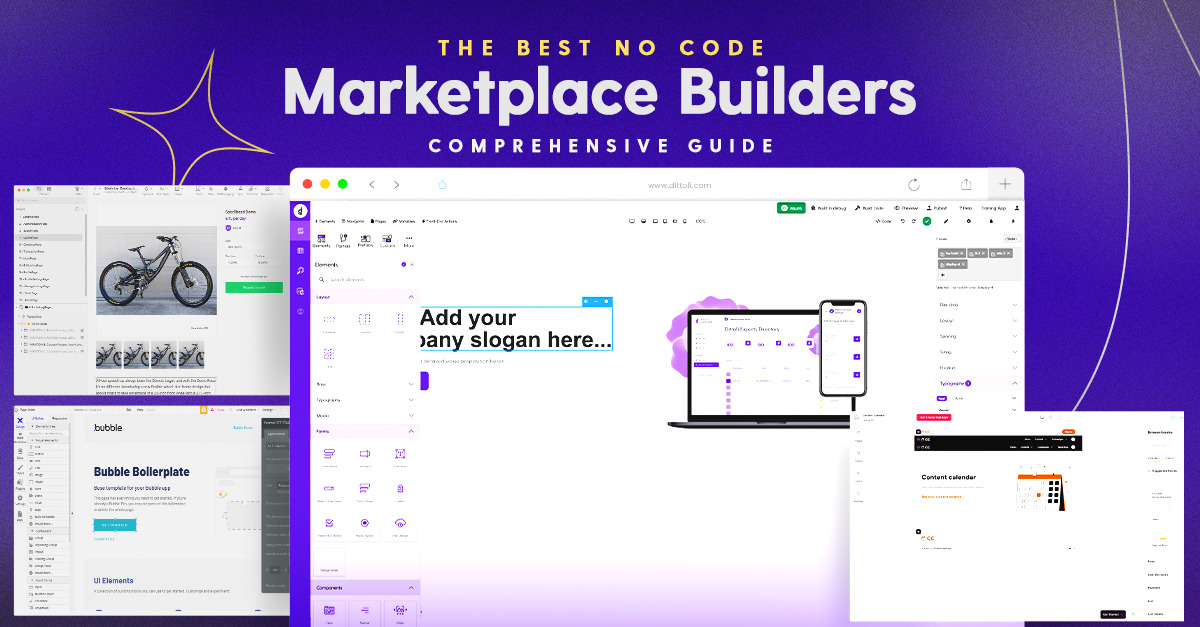A no code marketplace builder is a software platform that enables users to create online marketplaces without the need for traditional programming or coding skills.
These platforms typically provide intuitive drag-and-drop interfaces, pre-built templates, and a variety of customizable components, allowing users to design and launch their marketplace websites or applications quickly and easily.
In this article we take a look at our picks for the best no code marketplace builders.
The best no code marketplace builders
- Dittofi for professional grade marketplace development.
- Bubble marketplace template with good community support.
- Softr marketplace template, the best builder for beginners.
- Sharetribe for prototype and MVP marketplace development.
Our best marketplace software and marketplace comparison articles are written by humans who have spent much of their careers building and scaling online marketplaces. Unless explicitly stated, we have spent thousands of hours researching and testing the different solutions.
Our viewpoint is that there is no “best” marketplace solution. Instead, the choice of marketplace solution boils down to your technical skill set, access to resources and what you’re looking to accomplish. Therefore, we aim to present the different tools in a matter of fact way and we leave it up to you to choose which solution is best for you.
The best way to build a marketplace with no code is to break up your development into different phases. These are:
- Phase 1 (Build your online marketplace MVP): The goal of this phase of your marketplace development is to rapidly launch your marketplace, so that you can start working with real users to get feedback on your solution.
- Phase 2 (marketplace iteration): At this stage, the objective is to iterate quickly on your marketplace MVP by adding new features based on customer feedback.
- Phase 3 (marketplace scale up): Now that you have a feature set that works for your target buyers and sellers, the next step is to optimize core features of your marketplace. At this stage you will be fine tuning your most valuable features, reducing marketplace hosting costs to improve your profit margins and optimizing your marketing and sales funnels.
The best no code marketplace builders give you the tools to achieve each of these different stages fast and at a lower cost than traditional development.
As such, in our list of top marketplace platforms we look for solutions that take you through each different stage of your marketplace journey. Some of the tools are not able to cover all three phases but, each tool has its place depending on the stage that you’re in, your timelines and access to technical resources.
Here is a list of what we look for when testing different no code marketplace software.
- Feature rich marketplace template to get started fast
Two sided, peer to peer marketplaces are complex and time consuming to develop, even using no code. This is because peer to peer marketplaces require a large number of must-have features, just to launch. As such, we focus here only on those no code technologies that come with template marketplace solutions that include the core features two sided marketplace features.
- Fast launch with no coding required
The primary goal of your marketplace MVP is to launch fast and at a low cost. In contrast to this, coding is expensive and slow. Our list of the top no code marketplace builders therefore includes only platforms where you need to write absolutely no code to get from idea to go live.
- Flexibility to optimize your marketplace
Once your marketplace is live, you need to be able to customize your marketplace to quickly implement new features based on your customer feedback. This will enable you to limit your customer churn and retain early adopters. In order to do this, you need to choose a no code marketplace builder that is flexible enough that you don’t get tripped up by a feature limitation. Keep in mind that the easier to use marketplace builders cannot compete with those that have a more demanding learning curve.
- Quality tech stack to scale
You wouldn’t bake a cake with low quality ingredients, so why would you build your marketplace on a low quality tech stack? Since technology is always evolving, we look for no code marketplace builders that use modern, high performing technologies. We will consider which of these technologies will empower you to scale efficiently and which solutions will hold you back. Key things that we consider are how well each platform functions for search engines, the cost of hosting your marketplace and the ability to access your marketplace’s source code (more on this later).
- Help and documentation
As already mentioned, building a peer to peer marketplace is complex. There are lots of features and decisions you need to make regarding how your marketplace will actually work. For example, does your marketplace require a multi-vendor shopping cart? How is your transaction flow expected to work? How will you implement different marketplace business models?
Having a good knowledge base around how the no code marketplace builder works however, there should also be good documentation regarding how to build different types of marketplaces such as product, service and rental marketplaces as well as how key features of their marketplace solution works.
- Code access and intellectual property ownership
While no-code marketplace builders offer great flexibility, lacking code access inevitably leads to limitations. Though accessing your marketplace’s code may seem daunting, the real fright comes when scalability issues arise, necessitating a complete rebuild. Therefore, having a code export feature included in your no code marketplace builder is essential for long term sustainability.
That said, code export is a new concept in no-code marketplace builders, and our list would be far shorter if we only recommended tools that allowed you to export your code. Therefore, our list of the best no code marketplace builders includes both traditional no code builders and more modern hybrid no code solutions as well as pure no code solutions.
Marketplace technology vs no code marketplace platforms
Before we jump into the best no code marketplace software, let’s draw a quick distinction between no code and specialist marketplace technology.
In essence, no code marketplace builders are distinct from specialist marketplace technology because they offer visual no-code editors, which are lacking in traditional marketplace technology platforms.
However, it’s worth noting that certain marketplace technologies incorporate visual studios. As a result, our list of top no code marketplace builders extends to encompass specialist marketplace technology platforms like Dittofi and Sharetribe.
For a better understanding of marketplace technology, read “How to choose your marketplace technology“.
The best no code marketplace builders and glance
Our top picks for the best no code marketplace builders at a glance.
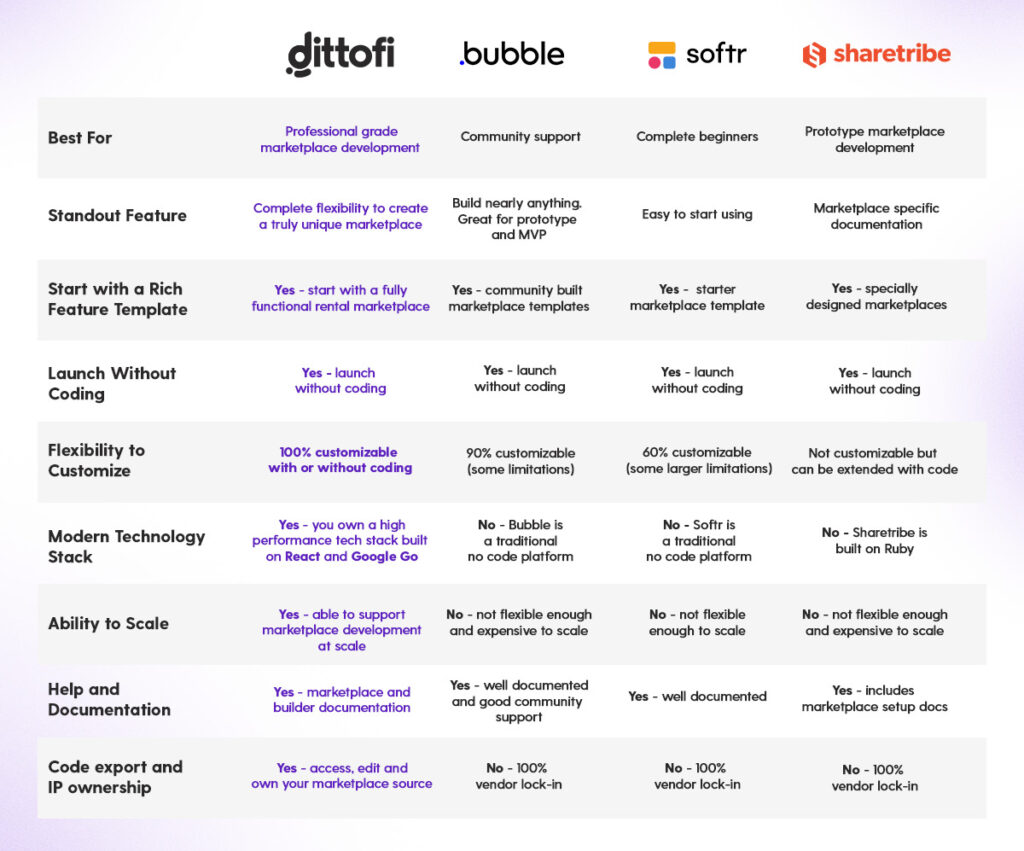
Dittofi is best for professional development
Dittofi pros:
- Choice of three professionally designed marketplace templates to start from
- A visual development studio that is as flexible as code (React and Google Go).
- Scalable marketplace hosting
- Quality code exports. Access, edit and own your marketplace source code and intellectual property.
Dittofi cons:
- With more flexibility comes a more demanding learning curve
- Smaller community of Dittofi Experts
- New and evolving technology
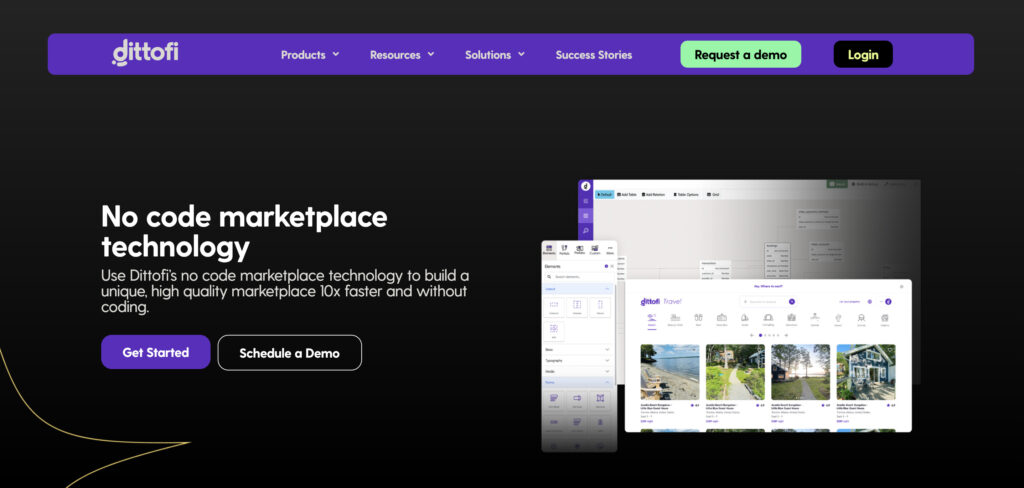
Dittofi is a hybrid no code platform that allows you to build an enterprise grade marketplace without coding. To do this, Dittofi offers three professionally developed marketplace templates:
Each template can be installed and rapidly customized using Dittofi’s visual development studio. All visual updates are transformed into code that is simple, secure and scalable. This code can then either be deployed in a single click or exported and handed off to developers.
The video below shows an example of how you can quickly and easily set up a rental marketplace using Dittofi’s no code marketplace solution.
Learn more about Dittofi’s no code marketplace builder.
Bubble marketplace template, community developed
Bubble pros
- Lots of Bubble marketplace templates to choose from
- Highly customizable no code marketplace builder
- Large community of Bubble developers
Bubble cons
- High learning curve for new users
- Not designed to build a scalable marketplace
- No option to export your code, leads to vendor lock-in
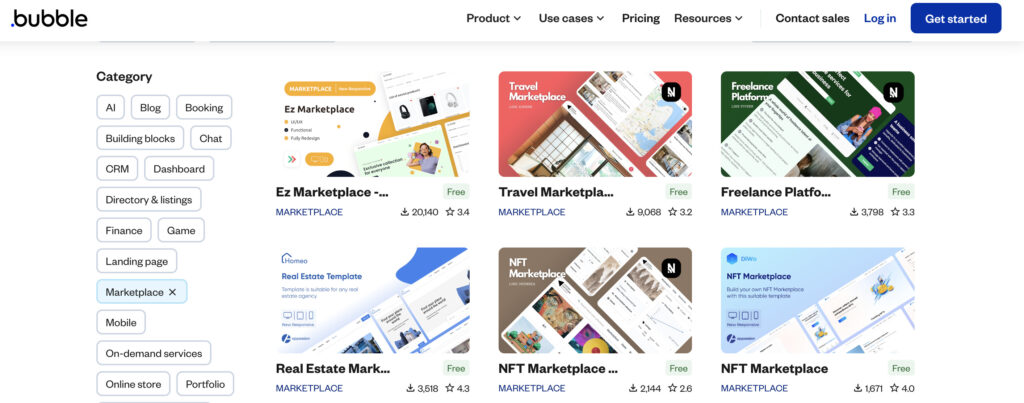
Bubble is a traditional no code platform that has developed its own, esoteric visual programming language.
As a no code marketplace builder, Bubble has a number of marketplace templates that have been developed by the Bubble community. These templates serve as a foundation for your no code marketplace development. The Bubble marketplace templates range from simple and free marketplace landing pages to more expensive, full blown two sided marketplaces.
Each template is customizable from within Bubble’s no code builder. However, although Bubble offers extensive customization options, there are some limits when compared to traditional coding. Furthermore, if you lack experience working with Bubble, customization will require learning and practice.
Bubble marketplace templates allow you to jumpstart your marketplace development however, these solutions often contain bugs or errors. Since they are community developed we advise you to check the template reviews before purchasing any Bubble marketplace template.
Lastly, Bubble does not enable you to scale easily. We’ve written an extensive guide on the scalability challenges that you will encounter with Bubble in separate articles. As a brief note here, the main reasons that Bubble is difficult to scale includes: high hosting costs, limited customization compared to traditional code, platform slowness at scale and no code export option which leads to vendor lock-in.
For marketplaces however, the major challenge is found in Bubbles’ approach to search engines. Marketplace listing pages built on Bubble do not rank well on Google. This is a major limitation for marketplaces since, getting your marketplace listing pages to appear in the search engine results pages (SERPs) is s major source of organic lead generation for any marketplace.
All that being said, Bubble has spent a huge amount of investment developing their community. This means that Bubble has a large number of users building marketplaces and so it’s possible to find very low cost Bubble marketplace developers. As such, we would recommend Bubble for people who can’t afford to invest heavily into their marketplace development. And for those who place value in building marketplaces within a vibrant community.
Read Dittofi vs Bubble for more information.
Softr no code marketplace, best for beginners
Softr pros:
- Very easy to start using
- Marketplace template
Softr cons:
- Limited advanced logic
- Marketplace template is limited
- Not designed to scale
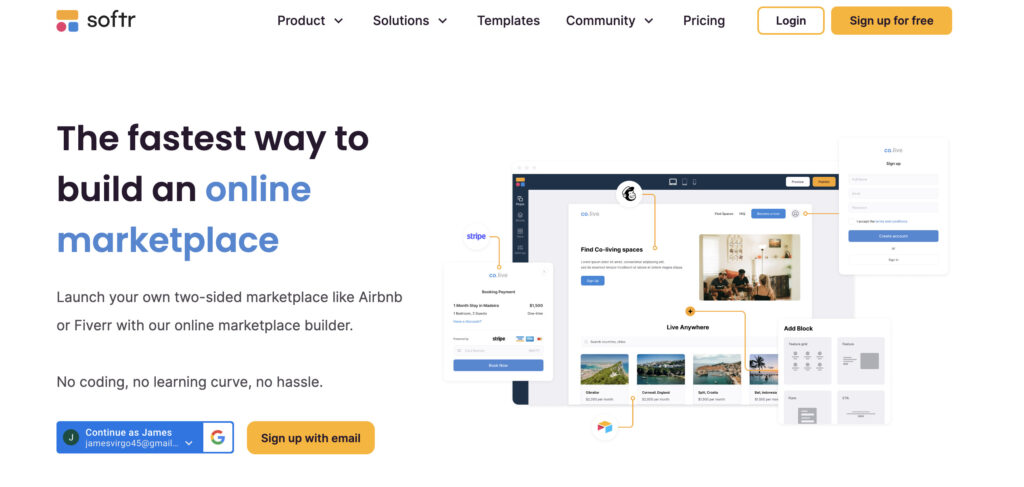
Softr’s no code marketplace solution includes several marketplace templates. You can use these templates to build marketplaces for rentals, freelancers and products. Each of Softr’s no code marketplace templates comes with the core features required for each type of marketplace.
Softr integrates natively with data sources such as Google Sheets and Airtable. This makes it easy to upload any existing inventory or freelancer profiles to kick start your marketplace. Softr is also a very well documented no code platform although their marketplace documentation and support is non-existent since their focus is only on providing general no code documentation.
Softr’s ease of use is high however, this comes with some quite major trade offs. Customization is highly limited compared to more powerful tools like Bubble or Dittofi. Furthermore, their marketplace templates cannot compare to the specialist marketplace technologies like Dittofi or Sharetribe.
Lastly, Softr is not appropriate for marketplaces that are looking to scale. This is because Softr does not offer any backend development capabilities, is highly limited in terms of frontend customization and there also exist some challenges around search engine optimization that can impact your ability to rank listing pages on Google.
All that being said. We recommend Softr for beginners looking to build a marketplace with no code. This is because it is fast to get started, you will learn a lot without needing to hire a developer and Softr is limited enough that you will not be able to grow too much before needing to transition. This makes Softr’s no code marketplace builder perfect for beginners just getting started with no code marketplace development.
Sharetribe marketplace software for prototypes
Sharetribe pros:
- Fast to get started
- Specialized marketplace templates and training
- Option to extend your marketplace with code. For this you need to hire developers.
Sharetribe cons:
- Impossible to customize without hiring a developer
- Highly limited no code marketplace builder
- Built on a less performant tech stack

Sharetribe is a specialist marketplace technology with a basic no code interface for founders to build prototype and marketplace MVPs (minimum viable products) without coding. The solution comes with one marketplace template that can support the development of rental, service and product marketplaces.
Using Sharetribe’s no code marketplace platform, you can quickly and easily build the first version of your marketplace without any coding. The platform supports this with a guided onboarding process which takes you through key steps that you need to take to launch your marketplace such as, setting up stripe, configuring your provider payout options and so on. Furthermore, the platform comes with a very large number of video tutorials that explain how to set up the business side of a two sided marketplace.
Sharetribe is a specialist marketplace technology. This means that the feature set you get with the builder is far more advanced than the more general no code marketplace templates offered by Softr, Bubble or Glide. However, Sharetribe does not have an advanced no code platform. This means that it is not possible to extend their marketplace template beyond version 1, without writing code.
Furthermore, Sharetribe does not scale efficiently in terms of hosting costs and the costs of extending the system. For instance, to extend the solution past version 1, you will need to hire expensive full stack developers. If you take this route, we advise that you hire developers who have experience building the specific type of marketplace that you’re looking to develop e.g. product, service, rental and that has experience working with Sharetribe’s system.
Lastly, Sharetribe is built using a programming language called Ruby on the Rails. Ruby is a good choice of coding language for building quick web applications however, it is not generally used for enterprise applications. Ruby does not compare in terms of performance, scalability or growing popularity to more modern programming languages like Google Go. For more information on Go vs Ruby, read our article Google Go vs Ruby on the Rails: A business perspective.
Taking into consideration all of these points, we recommend Sharetribe no code marketplace builder for quality prototypes and MVPs. The solution provides a very carefully designed marketplace template however, this template is difficult to extend without coding. Furthermore, the platform is built on a slightly dated tech stack that will be expensive to run and maintain compared to more modern alternatives.
Read Dittofi vs Sharetribe for more information.
Conclusion: The right marketplace builder for you
Building a marketplace should be fun, honestly. And by now you should have a good idea which no code marketplace builder is best for your project. Ultimately your choice comes down to what you can actually use to get your marketplace live.
Platforms such as Dittofi are extremely powerful and can help you develop an enterprise grade marketplace on a modern tech stack in hours; however, learning how to customize your marketplace has a demanding learning curve. Of course you can always hire a Dittofi Expert to help you build your marketplace but this will require you to invest more resources into your project.
In contrast, tools like Softr enable you to build a marketplace in minutes and with almost no learning curve. These platforms are significantly more limited and are only good enough for prototyping new ideas however, this may be enough for your stage.
If you’re thinking about building a marketplace and are interested, feel free to schedule a call with one of our marketplace specialists who will help guide you on what technology is best for you. Otherwise, in case we don’t speak… best of luck with your marketplace journey!
The Dittofi Team
Become a Marketplace Insider
Join our inner circle for exclusive insights, coveted trade secrets, and unparalleled strategies – your journey to marketplace dominance begins here.

